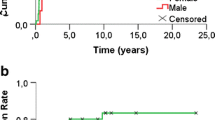Abstract
Post-surgical ablation of thyroid residues with 131-iodine (131-I) is usually recommended after near-total thyroidectomy in highrisk patients, including children, with differentiated thyroid cancer (DTC). We report here the results of post-surgical radioiodine thyroid ablation in 249 children and adolescents of Ukraine with post-Chernobyl DTC initially treated with neartotal thyroidectomy at the Institute of Endocrinology and Metabolism in Kiev, during a 2-year period. The patients’ age at the time of the Chernobyl accident (1986), ranged from < 1 to 14 yr in 223 subjects (children) and from 15 to 18 yr in 26 subjects (adolescents). Six weeks after surgery a diagnostic 131-I whole body scan revealed the presence of residual thyroid tissue in all cases. All patients received one or more courses of radioiodine therapy, for a total of 468 courses. One hundred and twenty-nine out of 249 patients (51.8%) were successfully ablated. The total number of treatment courses needed in these patients was 219. Most patients required multiple doses of radioiodine, only 63 required a single dose. One hundred and twenty patients (48.2%) treated with radioiodine were not ablated and are still under treatment program. The clinical features and the amount of thyroid residue were not different in ablated or not-ablated patients. Our results indicate that in this particular population of post-Chernobyl thyroid carcinomas, thyroid ablation is a rather difficult task. Only 51.8% were successfully ablated. Possible explanation for this finding may be the young age of the patients, other particular features of post-Chernobyl thyroid carcinoma or technical aspects, such as less radical surgical procedures.
Similar content being viewed by others
References
Dulgeroff A.J., Hershman J.M. Medical therapy for differentiated thyroid carcinoma. Endocr. Rev. 1994, 15: 500–515.
Solomon D.L., Wartofsky L., Burman K.D. Current trends in the management of well differentiated papillary thyroid carcinoma. J. Clin. Endocrinol. Metab. 1966, 81: 333–339.
Schlumberger M. Papillary and follicular thyroid carcinoma. N. Engl. J. Med. 1998, 338: 297–306.
De Groot L.J., Reilly M. Comparison of 30-and 50-mCi doses of iodine-131 for thyroid ablation. Ann. Inter. Med. 1982, 96: 51–53.
Goolden A.W.G. The use of radioactive iodine in thyroid carcinoma. Eur. J. Cancer Clin. Onc. 1988, 24: 339–343.
Wartofsky L., Sherman S.I., Gopal J., Schlumberger M., Hay I.D. Therapeutic controversy. The use of radioactive iodine in patients with papillary and follicular thyroid cancer. J. Clin. Endocrinol. Metab. 1998, 83: 4195–4203
Grebe S.K.G., Hay I.D. Follicular cell-derived thyroid carcinoma. In: Arnold A. (Ed.), Endocrine neoplasms. Kluwer Academic Publishers, Boston, 1997, p. 91.
Pacini F., Lari R., Mazzeo S., Grasso L., Taddei D., Pinchera A. Diagnostic value of a single serum thyroglobulin determination on and off thyroid suppressive therapy in the follow-up of patients with differentiated thyroid cancer. Clin. Endocrinol. (Oxf). 1985, 23: 405–411.
Pacini F., Elisei R., Fugazzola L., Cetani F, Romei C, Mancusi F, Pinchera A. Post-surgical follow-up of differentiated thyroid cancer. J. Endocrinol. Invest. 1995, 18: 165–166.
Schlumberger M., Baudin E. Serum thyroglobulin determination in the follow up of patients with differentiated thyroid carcinoma. Eur. J. Endocrinol. 1998, 138: 249–252.
Dean D.S., Hay I.D. Prognostic indicators in differentiated thyroid carcinoma. Cancer Control 2000, 7: 229–239.
Mazzaferri E.L. Long-term outcome of patients with differentiated thyroid carcinoma: effect of therapy. Endocr. Pract. 2000, 6: 469–476.
Nikiforov Y., Gnepp D.R. Pediatric thyroid cancer after the Chernobyl disaster. Pathomorphologic study of 84 cases (1991–1992) from the republic of Belarus. Cancer 1994, 74: 748–766.
Williams E.D., Pacini F., Pinchera A. Thyroid cancer following Chernobyl. J. Endocrinol. Invest. 1995, 18: 144–146.
Pacini F., Vorontsova T., Demidchik E.P., Molinaro E., Agate L., Romei C., Shavrova E., Cherstvoy E.D., Ivashkevitch Y., Kuchinskaya E., Schlumberger M., Ronga G., Filesi M., Pinchera A. Post-Chernobyl thyroid carcinoma in Belarus children and adolescents: comparison with naturally occurring thyroid carcinoma in Italy and France. J. Clin. Endocrinol. Metab. 1997, 82: 3563–3569.
Schlumberger M., Arcangioli O., Piekarski J.D., Tubiana M., Parmentier C. Detection and treatment of lung metastases of differentiated thyroid carcinoma in patients with normal chest x-ray. J. Nucl. Med. 1988, 29: 1790–1794.
Tronko M., Bogdanova T., Komissarenko I.V., Epstein O.V., Oliynyk V., Kovalenko A., Likhtarev I.A., Kairo I., Peters S.B., LiVolsi V.A. Thyroid carcinoma in children and adolescents in Ukraine after the Chernobyl nuclear accident. Cancer 1999, 86: 149–156.
Maxon III H.R., Smith H.S. Radioiodine-131 in the diagnosis and treatment of metastatic well differentiated thyroid cancer. Endocrinol. Metab. Clin. North Am. 1990, 19: 685–718.
Samuel A.M., Rajashekharrao B. Radioiodine therapy for well-differentiated thyroid cancer: a quantitative dosimetric evaluation for remnant thyroid ablation after surgery. J. Nucl. Med. 1994, 35: 1944–1950.
De Klerk J.M.H., De Keizer B., Zelissen P.M.J., Lips C.M.J., Koppeschaar H.P.F. Fixed dosage of 131-I for remnant ablation in patients with differentiated thyroid carcinoma without pre-ablative diagnostic 131-I scintigraphy. Nucl. Med. Commun. 2000, 21: 529–532.
Doi S.A.R., Woodhouse N.J.Y. Ablation of the thyroid remnant and 131-I dose in differentiated thyroid cancer. Clin. Endocrinol. (Oxf.) 2000, 52: 765–773.
Author information
Authors and Affiliations
Corresponding author
Rights and permissions
About this article
Cite this article
Oliynyk, V., Epshtein, O., Sovenko, T. et al. Post-surgical ablation of thyroid residues with radioiodine in Ukrainian children and adolescents affected by post-Chernobyl differentiated thyroid cancer. J Endocrinol Invest 24, 445–447 (2001). https://doi.org/10.1007/BF03351045
Accepted:
Published:
Issue Date:
DOI: https://doi.org/10.1007/BF03351045



